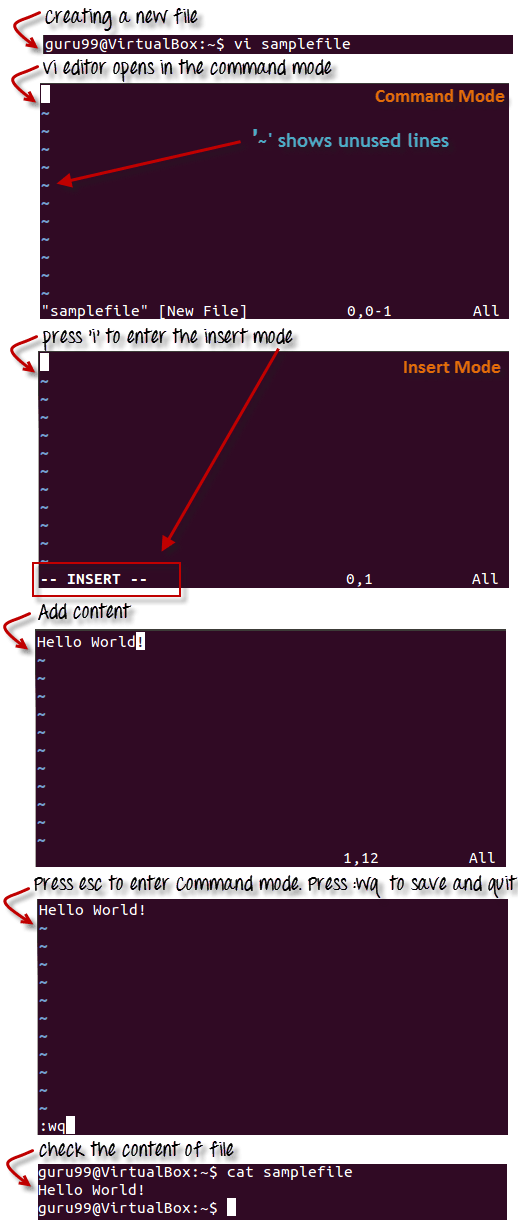VI Editor with Commands in Linux/Unix Tutorial
- Details
What is the VI editor?
The VI editor is the most popular and classic text editor in the Linux family. Below, are some reasons which make it a widely used editor –
1) It is available in almost all Linux Distributions
2) It works the same across different platforms and Distributions
3) It is user-friendly. Hence, millions of Linux users love it and use it for their editing needs
Nowadays, there are advanced versions of the vi editor available, and the most popular one is VIM which is Vi Improved. Some of the other ones are Elvis, Nvi, Nano, and Vile. It is wise to learn vi because it is feature-rich and offers endless possibilities to edit a file.
To work on VI editor, you need to understand its operation modes. They can be divided into two main parts.
In this tutorial, you will learn more about-
- vi Command mode
- vi Editor Insert mode
- How to use vi editor
- vi Editing commands
- Moving within a file
- Saving and Closing the file
vi Command mode:
- The vi editor opens in this mode, and it only understands commands
- In this mode, you can, move the cursor and cut, copy, paste the text
- This mode also saves the changes you have made to the file
- Commands are case sensitive. You should use the right letter case.
vi Editor Insert mode:
This mode is for inserting text in the file.
You can switch to the Insert mode from the command mode by pressing 'i' on the keyboard
Once you are in Insert mode, any key would be taken as an input for the file on which you are currently working.
To return to the command mode and save the changes you have made you need to press the Esc key
How to use vi editor
To launch the VI Editor -Open the Terminal (CLI) and type
vi <filename_NEW> or <filename_EXISTING>
And if you specify an existing file, then the editor would open it for you to edit. Else, you can create a new file.
VI Editing commands
- i - Insert at cursor (goes into insert mode)
- a - Write after cursor (goes into insert mode)
- A - Write at the end of line (goes into insert mode)
- ESC - Terminate insert mode
- u - Undo last change
- U - Undo all changes to the entire line
- o - Open a new line (goes into insert mode)
- dd - Delete line
- 3dd - Delete 3 lines.
- D - Delete contents of line after the cursor
- C - Delete contents of a line after the cursor and insert new text. Press ESC key to end insertion.
- dw - Delete word
- 4dw - Delete 4 words
- cw - Change word
- x - Delete character at the cursor
- r - Replace character
- R - Overwrite characters from cursor onward
- s - Substitute one character under cursor continue to insert
- S - Substitute entire line and begin to insert at the beginning of the line
- ~ - Change case of individual character
Note: You should be in the "command mode" to execute these commands. VI editor is case-sensitive so make sure you type the commands in the right letter-case.
Make sure you press the right command otherwise you will end up making undesirable changes to the file. You can also enter the insert mode by pressing a, A, o, as required.
Moving within a file
- k - Move cursor up
- j - Move cursor down
- h - Move cursor left
- l - Move cursor right
You need to be in the command mode to move within a file. The default keys for navigation are mentioned below else; You can also use the arrow keys on the keyboard.
Saving and Closing the file
- Shift+zz - Save the file and quit
- :w - Save the file but keep it open
- :q - Quit without saving
- :wq - Save the file and quit
You should be in the command mode to exit the editor and save changes to the file.
Summary:
- The vi editor is the most popular and commonly used Unix text editor
- It is usually available in all Linux Distributions.
- It works in two modes, Command and Insert
- Command mode takes the user commands, and the Insert mode is for editing text
- You should know the commands to work on your file easily
- Learning to use this editor can benefit you in creating scripts and editing files.
.jpg)


